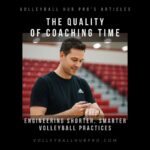The Evolution of Practice Planning
The evolution of volleyball and gains in sport science knowledge have prompted reexamination of long-held practice planning conventions. Where coaches once relied primarily on repetition of isolated mechanics and a limited tool set of drills, a modernized approach has become necessary. By delving more deeply into athlete development frameworks, coaches can design practice in a manner that drives continued progression.

Several factors provide opportunity for innovation. Firstly, newly available technological resources have expanded the educational toolkit. Video analysis platforms and telemetry capture diverse metrics, offering enriched feedback beyond informal observation. These help athletes gain self-awareness while informing coaches of subtle adjustments.
Secondly, greater understanding of motor learning encourages more pragmatic sequencing and periodization. Distributing practice across specialized sectors yields transferability from skills to their combined application. Altered environments retain competitive engagement as physical capacities change across stages. Individual needs also factor into periodized plans tailored for varied learning curves and attributes within a squad.
Furthermore, considering volleyball’s inherent unpredictability as an open-skill activity, carefully selected drills can better resemble authentic match situations. Random variables force quick problem-solving and foster flexibility, building resilience under pressure. Coaches attentive to such nuances find activities duplicating the challenge inherent to competition itself.
Advancing knowledge likewise compels re-examining core communication roles. Supporting athletes as they recognize patterns autonomously stands out among progressive techniques. Positive reinforcement along the learning journey motivates continuous striving toward long term development objectives, cultivating self-empowered competitors.
In all, practice represents the prime opportunity to influence a program holistically. An athlete-centered planning model holds coaches accountable for maximizing this valuable time. Progress depends on well-researched, dynamically applied methodology attuned to the multifaceted demands of the game.
Individualizing for Different Stages of Learning
Adapting practice content across phases proves essential to steady development. While technical fundamentals serve as building blocks, their usage progresses in complexity. Early on, acquiring a diverse vocabulary of techniques takes priority through repetition. Coaches emphasize quality execution against simplicity of application.
As comprehension deepens, maintaining drills in isolation loses relevance. Transitional phases commence integrating mechanics fluidly under various conditions. Practices cater increasingly toward game-like scenarios by incorporating multiple simultaneous demands. Drills require more advanced reading and prompt faster decision-making.
Likewise, seasonal shifts call for adjustment. General preparatory stages focus on rebuilding fitness and relearning motion patterns to avoid injury. Volume dominates as capacities renew. Meanwhile, competition draws near, intensity in drills climbs while low-impact recovery stays emphasized.
Comprehending athletes develop unevenly also factors into planning. Not all inherently grasp concepts simultaneously regardless of experience. Coaches offset such variability through differentiation. Less practiced athletes receive additional individualized attention to hasten comprehension, avoiding frustration that halts improvement. Yet high-achievers likewise get challenges befitting capabilities through further specialization or increased responsibility. Programs advancing all call for versatile application of methods.
Moreover, diversity occurs across age levels and gender. Younger athletes require patience through exploration and play while reinforcing basics. Leveraging enthusiasm, practice entertains as much as it teaches. For women, empowerment results from empowering self-confidence alongside skill development amid social expectations. A coach’s role proves at once coach and mentor through nuanced guidance.
Developing Well-Rounded Skills
A comprehensive practice approach facilitates balanced development across multiple physical and cognitive domains. No athletic attribute emerges independently, demanding an integrated model addressing all components jointly. Strategically designing activities to target technique, tactics, physical fitness and mental skills in parallel optimizes transfer to competition.
Technical sessions refine mechanics like passing, setting and attacking through repetition drills. However, incorporating additional demands beyond isolated skills forges connections between segments. Setting in combination or live-ball situations replicates realistic pressure of decision-making. Imposing time restrictions or accuracy criteria challenges execution under varying states.
Alongside individual work, tactics emerge as the framework for team-oriented problem-solving. Scrimmaging systematically addresses strategies like defensive positioning, block adjustments or offensive patterns. Coaches leverage teaching points arising from gameplay to impact subsequent technical work. Repetition solidifies both individual roles and the logic of synchronized movement.
Similarly, physical components such as strength, speed and endurance cannot develop apart from volleyball-specific activity. Designing technically-sound circuit training transforms strength stations into applicable multi-planar exercises. Conditioning incorporates the ball through extended rallies and specific intensity benchmarks. Recovery stays prioritized to avoid overexertion leading to injury or burnout.
Perhaps most demanding, the mental sphere necessitates as much focus for its inextricable link to consistency and poise. Introducing visualization, routine regulation and positive self-talk helps handle pressure. Coaches cultivate accountability while fostering realistic optimism and resilience through adversity. Implementing such holistic integration cultivates well-rounded, self-assured athletes.
Optimizing Communication and Decision-Making
On-court communication reflects a program’s foundations and merits dedicated shaping. Drills aim to replicate the hurried exchanges defining competitive play through carefully designed constraints. Coaches incorporate realistic variables into structured scenarios requiring quick problem-solving between teammates.
Repetition helps ingrain anticipating one another’s tendencies and tendencies of opposition. Yet maintaining engagement proves critical to prevent robotic execution. Randomizing variables like defensive positioning or ball placement challenges predictability, reflective of matches. Objectives reset to focus attention on essential messages rather than autopilot responses.
Moreover, practice messages aim for positivity and empowerment. Reinforcing successful application of cues and correction prevents fixation on past errors. Feedback emphasizes future improvement through specific adjustments rather than ambiguous critiques. Coaches shoulder responsibility for facilitating a psychologically safe learning environment.
Visual learning resources similarly influence communication maturation. Self-monitoring through video widens perception beyond physical senses to recognize missed details. Comparing performances throughout development underscores evolving comprehension of situations. External perspective supplements internal feelings which risk subjectivity.
Above all, entrusting ownership encourages independent operability under pressure. Designing drills calls for occasional removal of direct instruction and oversight to replicate pressure of high leverage moments. While guidance remains available, freedom inspires creative problem-solving and confidence in one’s own judgment. Coaches endorse rather than insert athletes into the decision-making process.
In the end, fostering interdependence between teammates forms the core of effective teamwork. Responsiveness evolves from collective investment in each other’s success. Progress emerges from channeling competitive energy cooperatively rather than at the expense of others. United teams flourish through shared vulnerability and accountability across all functions of the game.
Incorporating Game-Like Situations
Translating drills authentically to competition emerges among the foremost responsibilities in practice design. Yet reproducing a live match setting presents challenges necessitating resourcefulness. Coaches strive implementing optimal variability and unpredictability reflective of evolving in-game scenarios.
Beyond condensed situations, progressive coaches turn toward open-ended framework akin to prolonged rallies. Establishing parameters like continuous play, ball restrictions or positional constraints introduces organic flow similar to actual competition. Scorekeeping maintains intensity as outcomes matter despite loose structuring.
Moreover, randomization disrupts predictability within structures. Reordering serve and pass distributions challenges predictability honed through repetition. Unpredictable ball placements upon contacts compel fast adaptation to erratic situations rather than robotic repetition. Switching periodic rules alters strategic priorities to mirror adjustments opponents force.
Inclusion of all personnel rounds out simulated matches. Reserves participate fully rather than observing passively to preserve engagement throughout. Rotating court positions obliges handling unconventional roles regularly experienced due to substitution patterns. Full-team participation maintains matchday energy in preparation for unpredictable usages.
Above all, recreation strives providing peak pressure comparable to stakes of high-leverage competition. Tying tangible rewards like roster implications or privilege to subsequent practice reinforces competitiveness. Leveraging score or placement motivates and assesses simultaneously through stakes reminiscent of actual games. Practice emerges a proving ground mimicking importance of performance.
In the end, maximizing transferability stands among a coach’s foremost responsibilities. Practice plans hold coaches accountable for optimizing valuable time allotted to influence the program. Progress depends on thoughtful, experimentally applied methodology befitting sport’s intricate dynamics on and off the court.
Review and Improvement
Monitoring development underscores progressive planning discipline. Tracking benchmarks quantitatively provides objective metrics of physical enhancement, while qualitative assessment captures subtler evolution of intangibles. Coaches incorporate multiple lenses to achieve balanced perspective across technical, tactical, mental and interpersonal components.
Video proves a premier tool supporting self-analysis and ongoing refinement. Not only does review highlight mechanics for adjustment, it widens perception beyond physical senses. Visuals reveal miscommunications, defensive assignment errors or intensity fluctuations unseen to unaided observation. Self-review cultivates self-awareness critical to continual growth.
Statistically, objective metrics quantify physical capacities and skill accuracy. Benchmark testing yields data to validate conditioning progress and refine objectives. Meanwhile, metrics such as serve percentages or passing averages evaluate where technique warrants reprioritizing. Statistical tracking enlightens holistic physical preparation and targeted technical focus.
Qualitative factors including coach, player and peer evaluation rounds out review. Surveying involvement, confidence and cohesion exposes relational dynamics or leadership voids demanding attention. Observing composure under pressure indicates maturityhandling adversity. Self-assessments own responsibility while peer accountability fosters truthful perspective.
Perhaps most critically, comprehension of intelligent decision-making emerges as the pinnacle achievement. Drills assume supplementary value when demonstrating application across varied scenarios on the court. Coaches accentuate higher-order learning displaying cognitive fluidity amid chaos and maintaining poise under pressure when it matters most.
Overall, reflective review maintains relevance of practice beyond isolated performance. Insights guide continual refining, ensuring value of time invested and accountability in cultivating champions inclined not only toward skills but lives of constant betterment.
A Player-Centered Approach
Evolution within the game demands modernizing long-held coaching conventions to remain ahead of the curve. A player-centered planning model emphasizes maximizing available practice opportunities to affect perpetual advancement. Looking beyond isolated drills or repetitive mechanics alone, innovators center development methodologies on the growing person and competitor.
By considering diverse factors including motor learning phases, technological resources and ensuring practical transference, practice evolves as the heartbeat of progressive programs. Rather than passive observation or instructor reliance, athletes emerge empowered toward self-sufficiency under various conditions. Coaches emphasize equipping for challenges unforeseen in controlled environments to cultivate independent problem-solving.
Likewise, activity sequencing across year-round schedules necessitates periodized plans calibrated to physical maturation and abilities across diverse rosters. Individualization respects unpredictable learning curves while team strategies cater shifting priorities as competition approaches. Flexibility preserves motivation through diverse challenges befitting current capabilities.
Furthermore, incorporating all athletic attributes holistically optimizes well-rounded growth. Sessions integrate technique work with decision-making, conditioning components and instilling poise amid pressure integral to success. Coordinating interdependent skillsets establishes foundations for high-functioning unit cooperation.
Perhaps most substantially, practice venues serve to recreate competitive scenarios genuinely testing mental toughness and resilience. Randomizing variables disrupt predictability as volatility characterizes live matchups. Simulating stakes and rollercoaster emotional swings of results cultivates operability under greatest duress.
Above all, practice emerges the launchpad for life lessons beyond technique. Accountability to betterment drives continuous evolution, both within programs and throughout careers. Feedback nurtures perseverance amid setbacks on the developmental journey. Ultimately, practice facilitates elite-level training while shaping compassionate leaders of exemplary character through sport’s gifts.
If you are keen on delving into the modern methodology of volleyball training, read our Technical Book:
The Modern Practice Approach Developing
and Managing Volleyball Sessions








